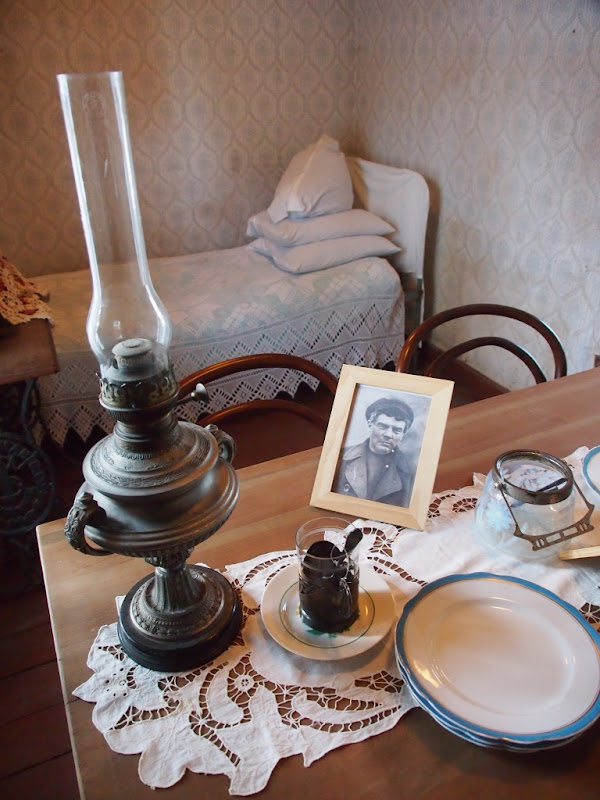In July 1917, after an armed demonstration by the Bolsheviks in St. Petersburg against the Russian Provincial Government turned violent, the Provisional Government issued an order for the arrest of more than forty prominent leaders of the Bolshevik Party, including Vladimir Lenin. To evade arrest and prosecution, Lenin and a fellow senior Bolshevik, Grigory Zinoviev, escaped St. Petersburg in disguise, but they didn’t went very far. Lenin decided to shelter just outside the city, in a small village called Razliv, so that could be in constant touch with party workers and keep abreast of the situation in the capital. He took refugee at the home of another Bolshevik worker, Nikolai Yemelyanov, who worked at the nearby Sestroretsk arms factory.

A replica of the hut where Lenin hid out during his stay in Razliv. Photo credit: Anna Pronenko/Panoramio
Lenin spent a few days in the hayloft of Yemelyanov’s barn, but when rumors reached St. Petersburg that Lenin was working as a fitter in the arms factory, it became obvious that couldn't stay there for long because Yemelyanov’s residence could be searched at any moment. So Yemelyanov transferred Lenin and Zinoviev in the guise of Finnish mowers to the deserted south-eastern shore of a lake. There, by the lakeside, in a small clearing surrounded by dense bushes, Yemelyanov helped Lenin and Zinoviev build a small hut from branches and covered with hay. A haystack was erected next to the hut, because Lenin and his friend would be living as Finnish peasant making hay.
Lenin tried to make the best he could of things. Two tree stumps served as table and chair. A large stack recess held papers and manuscripts brought to him by various members of Yemelyanov’s family, who also provided food for the fugitives. Near the hut, a pot hung from stakes where tea was made. For relaxation, Lenin and Zinoviev helped Yemelyanov mow the hay. They even went swimming. But at night mosquitoes made life miserable.
“It didn't matter how you hid from them, they would always get to where they wanted and they would frequently eat you. But there was nothing that could be done about it; you simply had to submit,” remembered Yemelyanov.
Only rain provided them relief, but it also made everything wet as the hay roof leaked like a sieve. It was under these terrible condition that Lenin started working on the book "State and Revolution", an exposition on how he believed the socialist state would develop following the proletariat revolution, and how from that point on the state would gradually wither away leaving a pure Communist society.

Yemelyanov’s barn, now fully enclosed over. Photo credit: www.razlivmuseum.spb.ru
Many leading Bolsheviks also came to visit Lenin in his hut under the cover of darkness. Yemelyanov’s son would stand guard, and at the sight of strangers would begin to whistle, imitating the call of a bird.
Once on a rainy day, Lenin was sitting inside the hut when a Cossack barged in to take shelter. When Lenin asked him what he was doing, the Cossack said that he was hunting for someone named Lenin. When questioned about the crime Lenin had committed, he couldn’t answer. All he knew, he said, was that the fugitive was “muddled” and very dangerous and that he was somewhere in the neighborhood.
Following this incident, and the sufferings from rain and mosquitoes finally lead Lenin and Zinoviev to abandon their hut. They remained by the lake until 8 August 1917 and then moved to Finland.
After Lenin’s death, Yemelyanov’s barn was declared a historic monument and a museum was opened in 1925. Later in 1970 on the occasion of the 100th birth centenary of Lenin it was fully encased in glass.
Lenin's Hut didn't survive for long, so in 1928 a memorial in the form of a granite hut was built at the location of his hay hut. Later an exact replica of the actual hut was also created. In 1969, not far from the hut, a museum was opened.
Photo credit: www.svetaphoto.com
Photo credit: www.razlivmuseum.spb.ru
The granite hut monument. Photo credit: Peter Ivanov/Wikimedia
Photo credit: Dimitriy Rusanov/Panoramio
Photo credit: www.razlivmuseum.spb.ru
Photo credit: kurort.spb.ru
Exhibits inside the museum. Photo credit: Peter Ivanov/Wikimedia
Exhibits inside the museum. Photo credit: Peter Ivanov/Wikimedia

Exhibits inside the museum. Photo credit: www.razlivmuseum.spb.ru
Photo credit: Peter Ivanov/Wikimedia
Sources: “Lenin: A Biography” by Robert Service / “Vladimir and Nadya: The Lenin Story” by Mary Hamilton-Dann / www.razlivmuseum.spb.ru / Wikipedia / BBC / Google Earth Community





















Comments
Post a Comment